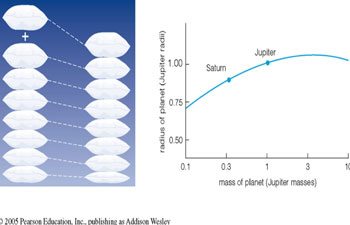
InteriorsInteriors
SUMMARY: The cores of all 4 jovian planets are made of some combination of rock, metal and hydrogen compounds. The difference between the jovian interiors remains in the layers that surround the core.
Planetary Size and Density
Interior Structure
Internal Heat
Related links
Related Lessons:
Looking Inside Planets
Planetary Size and Density
Have you ever wondered why Jupiter and Saturn are very close in size, but Jupiter's average density is almost twice Saturn's? The answer lies in how you build a planet out of hydrogen and helium. The process is similar to stacking pillows one on top of another. As more pillows are stacked on top, the pillows on the bottom become more and more compressed. The bottom pillows continue to compress until a point when adding pillows doesn't increase the height of the stack.
This helps explain why the radii of Jupiter and Saturn are very close, but Jupiter is more than three times as massive. Jupiter continued to collect hydrogen and helium in its atmosphere, increasing its mass and compressing its interior until its average density was twice Saturn's.
Average Density (from highest to lowest)
- Neptune 1,638 kg/m3
- Jupiter 1,326 kg/m3
- Uranus 1,270 kg/m3
- Saturn 687 kg/m3
Notice that even though Neptune and Uranus are smaller in size, their densities are much larger than Saturn's. This leads us to believe that Uranus and Neptune must have significantly different compositions than that of Saturn, with a much larger fraction of higher-density material such as hydrogen compounds and rock.
Interior Structure
All four jovian planet cores are similar in composition. Each consists of a mixture of rock, metal and hydrogen compounds. Their differences stem from having captured different amounts of additional hydrogen and helium gas from the solar nebula. Jupiter captured so much that it ended up with 300 times Earth's mass.

A Pie Slice of Jupiter's Density
LAYERS SURROUNDING JOVIAN CORES (FROM CORE OUTWARD):
Jupiter and Saturn
- Metallic hydrogen
- Liquid hydrogen
- Gaseous hydrogen
- Visible clouds
Uranus and Neptune
- Gaseous hydrogen
- Visible clouds
Density, temperature and pressure increase with distance from the cloud tops.
Internal Heat
The jovian planets get their heat from the Sun and from their interiors. Jupiter creates a lot of internal heat and releases this heat by emitting thermal radiation. In fact, Jupiter creates so much internal heat that it emits almost twice as much energy as it receives from the Sun. The only reasonable explanation is that Jupiter is still slowly contracting, almost as though it has not quite finished forming.
Saturn and Neptune also appear to be emitting more energy than they receive from the Sun. While we are certain Saturn is not still contracting, it seems clear that Neptune is still contracting. Uranus is the only jovian planet not emitting excess internal energy.
The Juno New Frontiers Mission Official Homepage



